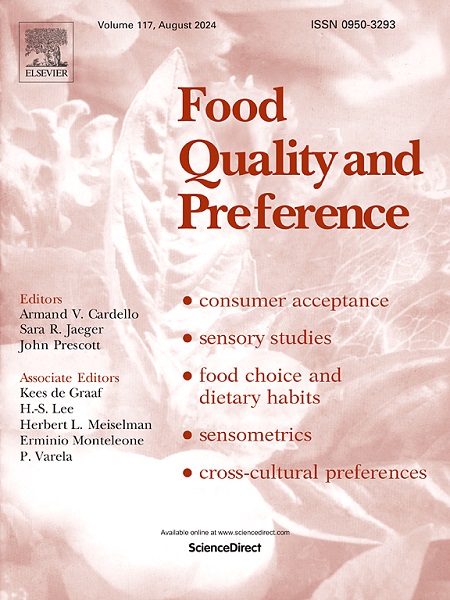Plant-based fish analogues vs. fish: Assessment of consumer perception, acceptance, and attitudes
IF 4.9
1区 农林科学
Q1 FOOD SCIENCE & TECHNOLOGY
引用次数: 0
Abstract
Plant-based fish is developed to mimic the taste, texture, and appearance of fish. Despite being the fastest-growing segment in plant-based analogues sales, it remains a niche product due to several hindrances, including sensory and nutritional issues. This study assessed consumer perception, attitudes and acceptance drivers of plant-based canned tuna involving 165 consumers who evaluated for liking and described through the Check-All-That-Apply method five plant-based and three animal-based samples. Consumers’ food neophobia level, food related lifestyles and food frequency consumption of a series of plant-based and animal-based products were investigated as potential explanatory variables in drivers of acceptance. Generalised linear models showed that plant-based samples scored very low (<40 VAS score), while animal-based products were well accepted (63.6 – 75.2). Principal Coordinate Analysis revealed that pink colour, tuna/fish flavour, and dryness characterised tuna samples and contributed positively to liking, while unappealing appearance, off-flavour, legume/vegetable flavour, bitterness, gelatinous and gumminess, characterised plant-based samples and contributed negatively to liking. Agglomerative hierarchical analysis identified two consumer clusters differing in liking for plant-based fish analogues. One cluster (27 % of consumers) showed significantly higher liking scores for all plant-based samples, a higher consumption of plant-based analogues and seemed more careful when buying food, both regarding its nutritional composition and its naturalness than the other cluster. This study suggests that the exploitation of plant-based ingredients (textured soy, pea and wheat proteins) affects all sensory dimensions of plant-based canned tuna and highlights the importance of sensory optimisation in the development of plant-based alternatives to meet consumer preferences.
植物性鱼类类似物与鱼类:对消费者认知、接受度和态度的评估
植物鱼的开发是为了模仿鱼的味道、质地和外观。尽管它是植物基类似物销售中增长最快的细分市场,但由于感官和营养问题等一些障碍,它仍然是一种小众产品。本研究评估了消费者对植物基金枪鱼罐头的感知、态度和接受驱动因素,共有 165 名消费者参与,他们通过 "全选-适用 "法对 5 种植物基样品和 3 种动物基样品进行了喜好和描述评估。消费者的食物新恐惧症水平、与食物相关的生活方式以及对一系列植物基和动物基产品的食物消费频率作为接受驱动因素的潜在解释变量进行了调查。广义线性模型显示,植物性样品的得分非常低(VAS 得分 40),而动物性产品的接受度较高(63.6 - 75.2)。主坐标分析表明,粉红色、金枪鱼/鱼味和干度是金枪鱼样品的特征,对喜好度有积极影响;而外观不美、异味、豆类/蔬菜味、苦味、胶状和胶质是植物性样品的特征,对喜好度有消极影响。聚合分层分析确定了两个消费者群组,他们对植物基鱼类类似物的喜好程度各不相同。其中一个群组(27% 的消费者)与另一个群组相比,对所有植物性样品的喜爱程度明显更高,植物性类似物的消费量也更高,而且在购买食品时,无论是在营养成分还是天然性方面,都显得更加谨慎。这项研究表明,植物基成分(质地大豆、豌豆和小麦蛋白)的使用会影响植物基金枪鱼罐头的所有感官维度,并强调了感官优化在开发植物基替代品以满足消费者偏好方面的重要性。
本文章由计算机程序翻译,如有差异,请以英文原文为准。
求助全文
约1分钟内获得全文
求助全文
来源期刊

Food Quality and Preference
工程技术-食品科技
CiteScore
10.40
自引率
15.10%
发文量
263
审稿时长
38 days
期刊介绍:
Food Quality and Preference is a journal devoted to sensory, consumer and behavioural research in food and non-food products. It publishes original research, critical reviews, and short communications in sensory and consumer science, and sensometrics. In addition, the journal publishes special invited issues on important timely topics and from relevant conferences. These are aimed at bridging the gap between research and application, bringing together authors and readers in consumer and market research, sensory science, sensometrics and sensory evaluation, nutrition and food choice, as well as food research, product development and sensory quality assurance. Submissions to Food Quality and Preference are limited to papers that include some form of human measurement; papers that are limited to physical/chemical measures or the routine application of sensory, consumer or econometric analysis will not be considered unless they specifically make a novel scientific contribution in line with the journal''s coverage as outlined below.
 求助内容:
求助内容: 应助结果提醒方式:
应助结果提醒方式:


